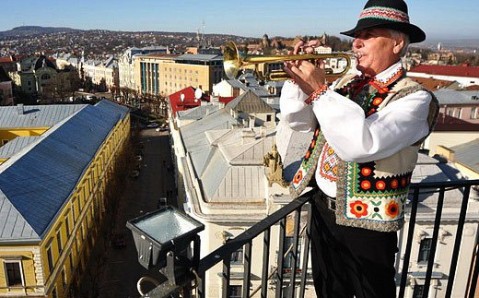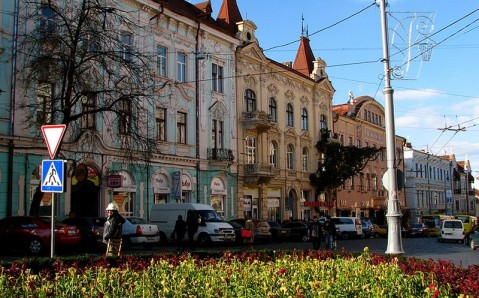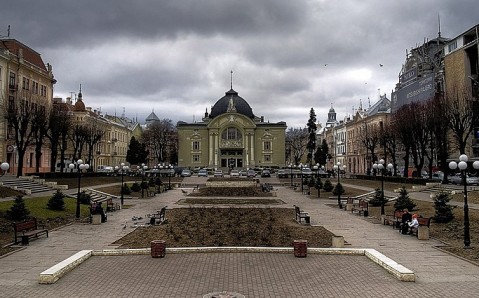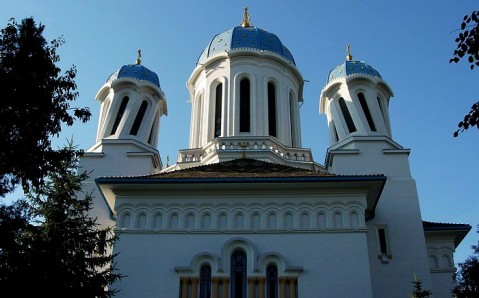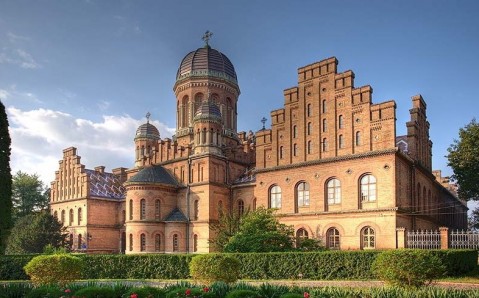Central Square and the Town Hall
The Central Square from where Chernivtsi main streets radiate is old town's heart and one of its most recognizable symbols. Square's architectural ensemble consists of elegant, as if emerged from a fairy-tale, buildings, is recognized as one of the most beautiful in Chernivtsi and embodies the unique look of Bukovina capital.
The Central Square appeared thanks to the Austrian Imperator Joseph II who visited the city in 1786. He suggested that local authorities create a spacious square at the then southern outskirts of Chernivtsi, where city market would function on week days and fairs would be organized on weekends and holidays. Considering its mission, the square was called Market, or Ringplatz. Few decades later, however, it stopped being a chaotic marketplace, acquired the first buildings and assumed civilized look.
At the same time - on the turn of the 19th century - square's architectural ensemble started to form. It gained complete and truly European look only with construction of the Town Hall, in 1847, which consolidated square's status as city center. The charming pastel blue building in the late classicism style interspersed with Renaissance motifs was immediately recognized as the most original construction in Chernivtsi.
The Town Hall is distinguished from other buildings in the Central Square ensemble by the jetting in the sky two-tier tower with the clock and observation ground, which can be reached by the inner winding stairs. Its balconies command breathtaking panoramas of the Old Town and Prut River valley. The Town Hall has its own tradition: every day at noon - regardless of the weather - a trumpeter, dressed in the Bukovina national costume, ascends its observation ground and plays a piece from the song 'Marichka' - Chernivtsi musical trademark. This performance gathers amazed tourists on the square.
Today the Town Hall is not only one of the city's most attractive buildings, but an integral part of its history: over more than 150 years of its existence, many crucial for Bukovina capital decisions were taken in the Town Hall building.
Another remarkable for its unusual appearance, three-story building stands next to the Town Hall. It is Directorate of Bukovina Savings Bank or Chernivtsi Olympus, as the locals used to nickname it. Built in the early 20th century, it was recognized as one of the most amazing buildings not only in Bukovina, but also in the whole Austro-Hungarian Empire (at that time the city was a part of it). The Directorate of Bukovina Savings Bank building is still rightly considered one of the most striking monuments of art nouveau architecture in the Eastern Europe.
The Chernivtsi Olympus attracts, in the first place, by its original facade decorated with mosaic panel depicting allegoric figures symbolizing Austro-Hungarian Empire's provinces - Bukovina is represented as dressed in goat hide youngster with a horse. Now the building of the former Bukovina Savings Bank is occupied by the Art Museum keeping the unique collection of paintings.
The bright gem of the Central Square architectural ensemble is its oldest stone building (House №7) - the building of the former hotel Black Eagle, which is now occupied by the main building of the Trade and Economic Institute. Located across the street, the five-story building of the hotel Golden Lion, which existed here in the early 20th century, is not inferior to it in its beauty. Today the only reminder of the hotel is the bas-relief of the lion that survived on the corner tower facade. Shops and Chernivtsi University's departments are located on the premises of the former hotel.
The last architectural element of the Central Square is the monument to the world-known Ukrainian poet Taras Shevchenko that appeared here in 1999.

 Western
Western



